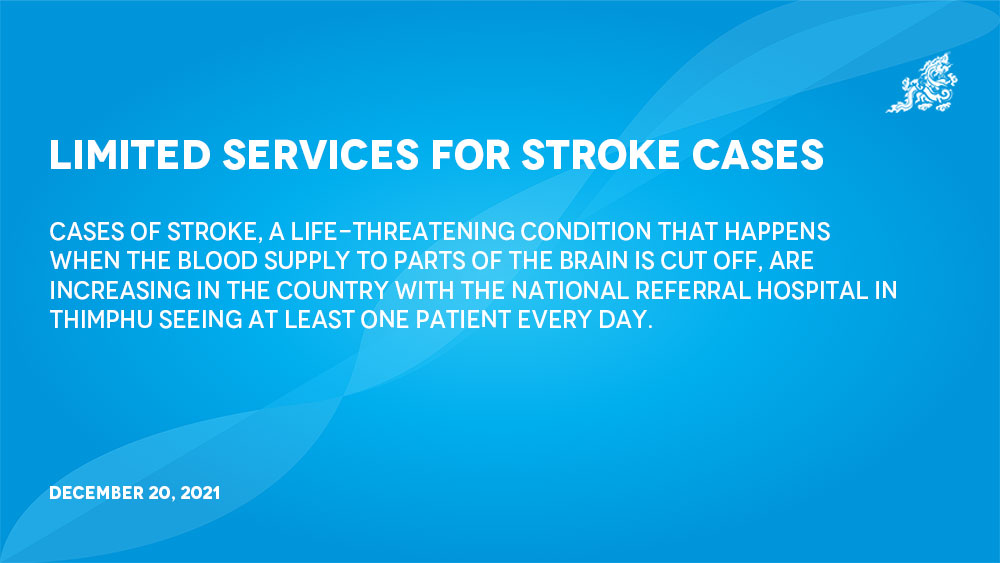Yangyel Lhaden
Cases of stroke, a life-threatening condition that happens when the blood supply to parts of the brain is cut off, are increasing in the country with the national referral hospital in Thimphu seeing at least one patient every day.
However, the hospital services to patients is limited to both stroke patients and post-stroke survivors because of limited physiotherapy and medical follow-up for the primary disease condition.
There are only three occupational therapists in the country. Occupational therapists are crucial for post-stroke survivors to build independence. Worse, there is no neurologist in the country to diagnose, treat, and manage cerebrovascular disease such as stroke.
Professor Dr (Colonel) Tashi Tenzin, consultant general surgeon and neurosurgeon, said that without a dedicated stroke unit in the country, those in need of stroke care can’t be given the needed holistic service so far.
He said that there is a need for dedicated stroke units in referral hospitals so that care for stroke patients is more focused and strengthened.
Without a neurologist, Dr Tashi Tenzin has been involved in treating and developing stroke care management since 2008. He said that the country has not been able to produce one neurologist so far and has not been able to hire one, as the specialty is limited in other countries too. “In 2010, we initiated blood clot dissolving injections and developed a standard operating procedure for stroke management.”
Dr Tashi Tenzin said that stroke is becoming a concern. He said that when he first joined as a neurosurgeon in 2008 there were very few cases but now, he receives phone calls almost every day about stroke cases from many hospitals across the country. “We are also seeing more young people suffering from strokes, mostly due to untreated hypertension. As non-communicable diseases increase and more people smoke, drink, and use illicit drugs, it is only going to become worse.”
The World Stroke Organization projects that ‘one in four’ will suffer a stroke if preventive measures like risk factors are not controlled seriously.
In the country, the main age group affected by stroke is between 50 and 70 with the majority being male (57 percent). About 62 percent are ischemic type of stroke which means blockage of blood vessels by a clot, and 38 percent from hemorrhagic.
The main causes of stroke are high blood pressure, diabetes, and heart conditions which are mainly due to high cholesterol, obesity, smoking, and alcohol, including substance abuse.
Dr Tashi Tenzin said that most obvious symptoms of stroke could be remembered as FAST. “F for facial drooping, A for arm dropping, S for speech change, and T for time to call an ambulance or rush to the hospital. Other symptoms are sudden headache and loss of consciousness.”
The neurosurgeon said that people must know strokes are preventable, and even strokes due to bleeding can be treated if treatment is administered early. “If an ischemic stroke patient arrives in the hospital within four hours, a cure is possible with injection, provided the patient is suitable to receive the treatment.”
He said that another form of treatment which is mechanical clot removal, which could be given beyond four and half hours, but within 24 hours was not available in the country. “Chances for recovery of these patients are minimal, as referral to higher centres in India is impossible.”
The injection for stroke patients is limited to regional hospitals with lack of CT scans and specialists in district hospitals. Dr Tashi Tenzin said that although the CT scan facility in referral hospitals is an achievement, machines alone are not enough. “After detecting strokes through CT scans, we need a dedicated stroke care team to manage them, the lack of which is still a concern.”
Hope
JDWNRH has initiated a project called Bhutan’s Response Against Increasing Numbers of Stroke (BRAINS) in collaboration with Christian Medical College Stroke Centre at Ludhiana, India with support from South East Asia Region World Health Organisation ( SEARO-WHO) last year.
Dr Tashi Tenzin said that through the project standard care record form, forming focal persons in the wards, training staff on management of stroke, drafting a Stroke Registry, and developing awareness materials were completed. “With a Stroke Registry we will be able to know the actual number of stroke cases, as currently stroke and non-stroke cases are filed together in the radiology department.”
He said that collaboration among three referral hospitals has been also developed and district hospital doctors have been sensitised on early referral of stroke cases. “We have also initiated the establishment of a stroke care unit in three referral hospitals.”
To provide post-stroke services, hospital technical staff involved in stroke care are also working with the recently formed Bhutan Stroke Foundation.
Dr Tashi Tenzin said that post-stroke survivors needed institutional, social, and family support systems.


